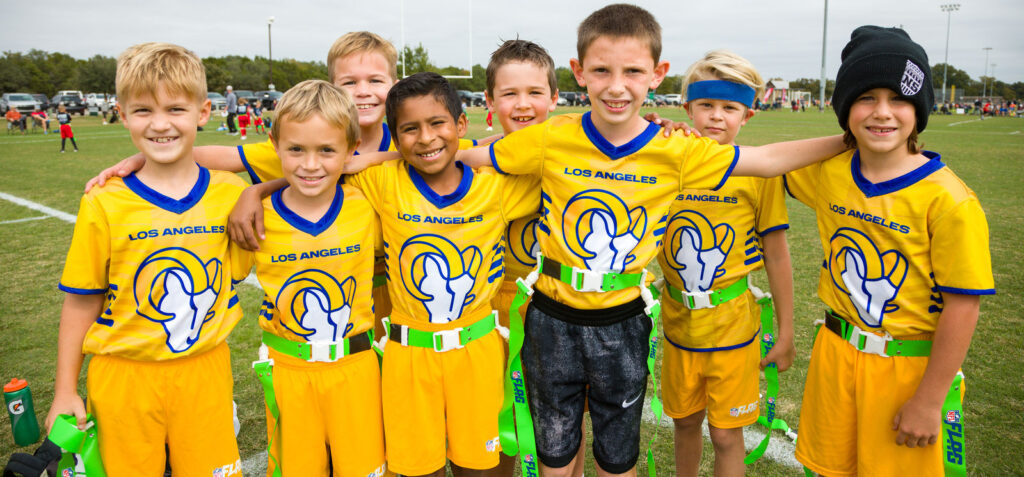As an Amazon Associate, I earn from qualifying purchases.
Football running back training equipment focuses primarily on agility ladders and blocking sleds. These tools enhance speed, power, and blocking techniques.
Training as a football running back demands specialized equipment to develop essential skills required for success on the field. Agility ladders are a staple in these athletes’ training regimes, improving foot speed and coordination. Meanwhile, blocking sleds strengthen a player’s ability to push against opponents and protect the ball.
Weighted vests and resistance bands are also instrumental in building muscle endurance and explosive power. Hand-eye coordination is fine-tuned using reaction balls, which prepare running backs for unexpected movements during gameplay. To hone in on ball security, high-grade footballs designed for grip strength are utilized. Combining this equipment with a rigorous training schedule, running backs can optimize their on-field performance and elevate their game.
The Importance Of Proper Training Equipment
Training equipment is vital for football running backs to enhance their game. Quality gear allows players to improve skills safely and effectively. Selecting the right equipment caters to skill development, strength, endurance, and agility. This leads to phenomenal performance on the field.
Enhancing Performance
Optimal training equipment boosts athletic ability. It supports varied workouts and drills tailored to running backs. Items like weighted vests, agility ladders, and parachutes elevate training intensity. They stimulate game-day scenarios, improving reaction times and explosiveness.
- Weighted Vests: Build core strength and stamina
- Agility Ladders: Enhance footwork and coordination
- Parachutes: Improve speed and resistance
Reducing The Risk Of Injuries
Using the right equipment also lowers injury risk. Running backs endure intense physical demands. Adequate gear like knee braces, ankle supports, and padded shirts protect vulnerable areas. This protection is crucial during high-impact drills and tackling exercises.
| Equipment | Benefits |
|---|---|
| Knee Braces | Provides joint stability |
| Ankle Supports | Reduces sprain risk |
| Padded Shirts | Cushions impacts |

Credit: www.houmatoday.com
Essential Equipment For Running Backs
Training to be a top running back in football requires not just skill and dedication, but also the right equipment. Equipment improves performance, ensures safety, and enhances the quality of training. Running backs need to equip themselves with tools designed to boost their game. Let’s explore the must-have gear for any aspiring running back.
Cleats
Selecting the perfect pair of cleats is a game-changer. Cleats offer the necessary grip and traction on the field, which is essential for making those swift and explosive movements. Lightweight yet sturdy options that provide ankle support without sacrificing speed are ideal. Look for cleats with excellent fit and comfort to minimize foot fatigue.
Pads And Protective Gear
Proper pads and protective gear safeguard a running back during intense physical confrontations.
- Shoulder pads absorb impact.
- Protective girdles with padding shield the thighs and tailbone.
- Using a mouthguard is non-negotiable for protecting teeth and reducing concussions.
Quality padding that balances protection with mobility is a must, ensuring athletes can move freely.
Speed And Agility Equipment
To increase speed and agility, running backs must train with specialized equipment:
| Equipment Type | Benefits |
|---|---|
| Cones and hurdles | Improve footwork and agility |
| Resistance bands | Build muscle strength |
| Speed ladders | Enhance coordination and speed |
Regular drills with these tools will fine-tune running backs’ quickness and reactive power.
Specialized Training Tools
Let’s cut straight to the chase. Specialized Training Tools are essential for any football running back aiming to elevate their game. These tools make the training tough but rewarding. Adopting them ensures that a running back can boost agility, strength, and speed.
Resistance Bands
Resistance bands are a running back’s best friend for increasing power.
- Boost leg and core strength.
- Enhance balance and stability.
- Portable for on-the-go workouts.
Integrating bands in squats and lunges targets muscle groups used on the field.
Sleds And Harnesses
Sleds and harnesses mimic on-field resistance. They build explosive speed.
- Attach the harness.
- Load the sled with weight.
- Run drills to simulate game-like resistance.
Consistent use improves acceleration and endurance.
Cones And Hurdles
Cones and hurdles fine-tune agility and footwork.
| Equipment | Function |
|---|---|
| Cones | Guide sharp cuts and directional changes. |
| Hurdles | Encourage high knees for improved stride. |
Regular drills increase mobility and coordination.
Technology In Training
The world of football is ever-evolving, and so are the training methods. Advanced technology equips running backs with the tools to enhance their performance. Let’s explore the gadgets shaping the future of football training.
Gps Trackers
Real-time tracking has become a game-changer in sports. GPS trackers are essential for measuring a player’s movement, speed, and endurance on the field. They provide valuable data to optimize workouts and prevent injuries.
- Speed Analysis: Monitors how fast a player moves in different drills.
- Distance Tracking: Calculates the total ground covered during training.
- Workload Management: Helps to balance intense training with adequate rest.
Virtual Reality Systems
Virtual reality (VR) systems transport players to a simulated field where they can practice plays and make decisions in a controlled environment. The immersive experience sharpens the mind and prepares the body for game-day situations.
| VR Training Benefit | Description |
|---|---|
| Cognitive Development | Enhances decision-making under pressure. |
| Play Memorization | Improves recall of complex playbooks. |
| Reaction Time | Reduces hesitation with rapid response training. |
Both GPS trackers and VR systems offer innovative ways to train smarter. They enable running backs to maximize their potential and bring their A-game to the field every time they play.
Diy Training Equipment Ideas
Aspiring football running backs can transform their game with effective training techniques. Not all athletes have access to professional equipment. Enter DIY! Simple tools can create an elite workout experience. Leverage these cost-effective DIY training gear ideas and boost your agility, strength, and speed.
Tire Drills
Training with tires enhances footwork and endurance. Drill tires into the ground for stability. Create a pattern for agility drills. Run, jump, and zigzag through to mimic in-game movements. Safety is key! Ensure tires are securely in place to prevent injury.
Homemade Agility Ladder
An agility ladder boosts foot speed and coordination. Making one is simple. Measure and cut the rope for the sides. Use evenly spaced duct tape for rungs. Arrange the ladder on a flat surface. Practice ladder drills for quick feet. Adjust the rung distance for different difficulties.
Here’s how you can craft these pieces:
- Gather old tires from a local garage for free.
- Secure them in your yard.
- Mark start and finish lines with chalk or tape.
For the agility ladder:
- Cut two long rope pieces.
- Place parallel to each other.
- Connect with duct tape every 18 inches.
Use these DIY training tools regularly. Notice improvements in your game. Add complexity over time to challenge yourself further.
Best Practices For Using Training Equipment
Shaping a formidable football running back requires not just talent but the right training equipment. Knowing how to use this gear effectively paves the way for peak performance. Best practices ensure athletes train safely, develop skills efficiently, and maintain equipment longevity. Get ready to dive into the proper usage of football running back training equipment.
Proper Fit And Maintenance
The axiom “safety first” holds true even on the football field. Equipment that fits well protects athletes from injury. Regular maintenance keeps gear in top condition. Inspect equipment before each use. Check for signs of wear like cracks or loose parts.
- Adjust straps for a snug, yet comfortable fit.
- Clean gear post-training to prevent the build-up of dirt and bacteria.
- Store equipment in a cool, dry place to avoid degradation.
Progressive Overload Approach
Incorporating progressive overload fosters strength and endurance. Start with lighter weights and fewer repetitions. Gradually increase the intensity over weeks. This method reduces injuries and builds power efficiently.
| Week | Weight | Repetitions |
|---|---|---|
| 1-2 | Low | High (15-20) |
| 3-4 | Medium | Moderate (10-15) |
| 5+ | High | Low (5-10) |
Guidance from a trained coach ensures the progressive strategy matches individual capabilities. Each back’s needs differ; training must reflect this. Always allow time for recovery. Muscles need rest to grow stronger.
Evaluating The Effectiveness Of Equipment
Choosing the right training equipment is key for any football running back.
The right tools can boost speed, agility, and power.
But how do you know if your gear is really working?
Let’s dive into how to measure the effectiveness of your training equipment.
Performance Metrics Tracking
To gauge equipment effectiveness, start with performance metrics tracking.
This approach quantifies your improvements.
- Speed drills record
- Agility course times
- Strength gains from weight training
Modern devices like wearables sync with apps for a detailed analysis.
They track your progress over time.
Player Feedback And Adaptations
Another vital component is player feedback.
After using the equipment, players should assess their experience.
- Comfort while training
- Any increase in skill levels
- Overall training experience satisfaction
Adaptations to training programs are crucial for continued progress.
They respond to feedback and performance metrics.
Equipment might need tweaks to better serve player needs.

Credit: www.deseret.com
Future Trends In Running Back Training Equipment
Running Backs gear up for the future! Training equipment is getting smart and technical. This means better performance on the field. Let’s explore the future trends in Running Back training equipment.
Integration Of Biomechanics
Understanding how your body moves is crucial. That’s where biomechanics comes in. In the future, running backs can expect equipment that offers:
- Real-time feedback on running form and technique
- Technology that helps prevent injuries by correcting posture
- Devices that track the efficiency of movements, optimizing performance
Training tools with built-in sensors will analyze every sprint and cut. They will tell players how to be faster and stronger with less chance of getting hurt.
Smart Wearables
Imagine clothes and gear that guide you to greatness. That’s what smart wearables are all about. Players will have:
- Shirts and wristbands that monitor heart rate and oxygen levels
- Shoes that measure the force of each step
- Smart helmets that track head impact for safety
These wearables will not only boost performance but also keep health in check. Coaches will use this data to tailor training plans. Players will stay on top of their game, safely and effectively.

Credit: www.amazon.com
Frequently Asked Questions Of Football Running Back Training Equipment
What Equipment Do Running Backs Need?
Running backs need a helmet, shoulder pads, cleats, gloves, and mouthguard for protection and performance on the field. Athletic tape and thigh and knee pads are also essential for injury prevention.
What Equipment Do I Need For Football Training?
For football training, you’ll need cleats, shin guards, a football, comfortable athletic wear, and a water bottle. Optional items include gloves for goalkeepers and training cones.
How Do You Practice Running Back?
To practice as a running back, focus on agility drills, strength training, improving your footwork, studying gameplay, and consistent ball-handling exercises. Regularly participate in sprinting activities and rehearse play executions to enhance your on-field performance.
What Does A Running Back Require?
A running back needs speed, agility, strength, ball-handling skills, and the ability to read defenses. They must also excel in teamwork and possess strategic vision to identify running lanes.
Conclusion
Fueling your passion for football requires the right gear. Embrace the training equipment highlighted to enhance agility, strength, and performance as a running back. Remember, the proper tools can be game-changers on the path to your athletic peak. Gear up, train hard, and let your talent shine on the field.
Amazon and the Amazon logo are trademarks of Amazon.com, Inc, or its affiliates.

